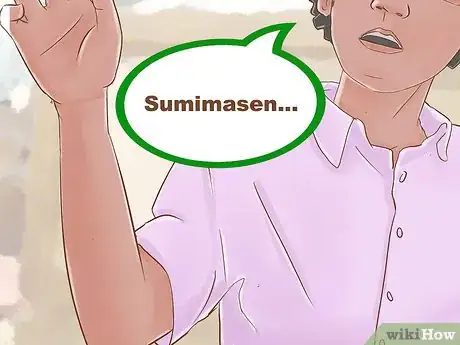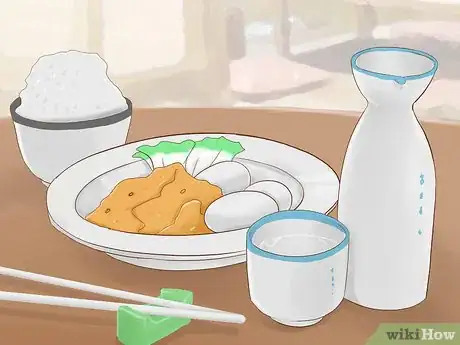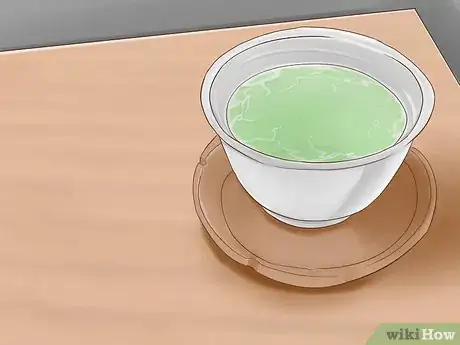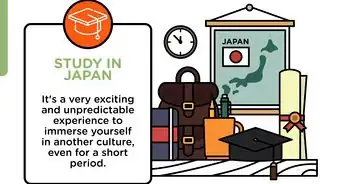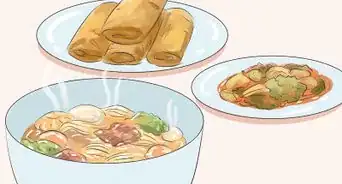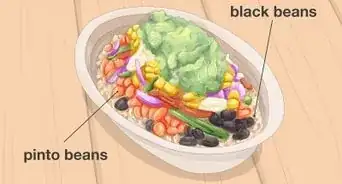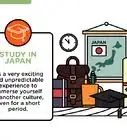This article was co-authored by wikiHow Staff. Our trained team of editors and researchers validate articles for accuracy and comprehensiveness. wikiHow's Content Management Team carefully monitors the work from our editorial staff to ensure that each article is backed by trusted research and meets our high quality standards.
There are 7 references cited in this article, which can be found at the bottom of the page.
This article has been viewed 194,158 times.
Learn more...
Japanese food is delicious, but for those who aren’t familiar with Japanese culture, the experience of ordering at a Japanese restaurant can be intimidating. The experience, however, doesn’t have to be nerve-racking. First, keep in mind that you aren’t expected to act as a native if you aren’t Japanese. Then, with just a little bit of knowledge about etiquette and language, your time at a restaurant can be fun and tasty!
Steps
Ordering Food
-
1Tell the host or hostess how many people are in your party. When you enter the restaurant, the host or hostess will greet you by saying “irasshaimase,” which means “welcome.” Then, this person will likely ask you how many people are in your party by saying “Nan mei sama desu ka?” If you have four people, for example, answer “Yon mei desu.”[1]
- For three people, you can say “San nin desu.”
- If you are eating alone, say “Hitori desu.”
-
2Ask for an English menu. If you are worried about understanding a Japanese menu, it’s perfectly acceptable to ask if they have an English menu available. To ask for a menu in English, say “Eigo no menyuu ga arimasu ka?” Often, a Japanese restaurant that sees a lot of English speaking tourists will offer them to you without asking.[2]
- If they don’t have one available, do your best to look up Japanese on a mobile device (if available) or work with what Japanese you know.
Advertisement -
3Ask about prices. To do this, you say “Kore wa ikura desu ka?” This means "How much does this cost?" If you don’t want to ask, you can also learn some Japanese numbers to get an idea about price.[3]
-
4Learn numbers to understand what is written on the menu. This isn’t absolutely necessary, but it is certainly helpful. Start with: ichi (一)=1; ni (二)=2; san (三)=3; shi/yon (四)=4; go (五)=5; roku (六)=6; shichi/nana (七)=7; hachi (八)=8; kyuu (九)=9; juu (十)=10; hyaku (百)=100; and sen (千)=1000.[4]
- You put the numbers together like this: 19 is 10 + 9 so it is juu-kyuu (十九). 90 is 9 sets of 10 so it is kyuu-juu (九十). So 198 is hyaku-kyuu-juu-hachi (百九十八).
-
5Ask for more time to look at the menu. The server may come over after a few minutes. If you are not yet ready to order, say “Mou sukoshi jikan wo itadakemasu ka?” This phrase means “Can I have a little more time?”[5]
-
6Call over a staff member. If the staff member hasn’t come over yet, you can hail the staff by calling, "Onegaishimasu" for please or "Sumimasen,” which means “excuse me.” Many nicer restaurants also have a call button you can push to summon your waiter.[6]
-
7Order an individual item with a drink. Ordering an individual item in Japanese is fairly simple. All you have to do is pair the name of the food or drink with the word “please.” For example, to ask for a tonkotsu ramen and a beer, say “tonkotsu ramen to bīru kudasai.” “Kudasai” means “please.”[7]
-
8Order more than one item. If you want more than one of a particular item, remember these words. Say (food or drink name) + wo + number using tsu + kudasai. For example, “Four waters please” is “Mizu wo yonku kudasai.” An example of the numbers ending is tsu is, hitotsu (one), futatsu (two), mittsu (three), and yottsu (four).[8]
- If you want more than ten of something, specify using normal numbers—juichi, juni, jusan, etc.
Eating Your Meal
-
1Wait until everyone has received their drink. It is polite to wait until everyone has received their drink to take a drink. When everyone has received their drink, say “kanpai!” This mean “cheers!” Now, everyone can enjoy their drinks.[9]
-
2
-
3Clean your hands before and during the meal. Often, you will be given a wet towel before the meal. This towel is meant to be used to clean your hands before and throughout the meal. You can place it on the table away from the food when you are not using it.[11]
-
4Express gratitude before eating your meal. It is customary to say “itadakimasu” before eating. Literally, this means "I receive (this meal).” It is an expression of gratitude for the meal you have just received.[12]
-
5Tell them if what you ordered is okay. When you have ordered and received your food, you may be asked “Daijoubu desu ka?” You were asked “Is everything ok?” Answer “Hai” for “yes” and “Iie” for “no.”[13]
-
6Use your chopsticks. Typically, chopsticks are used in Japanese restaurants over utensils such as forks. If possible, use your chopsticks with all of your food, except soup, which would be eaten with a spoon. It's okay to request a fork if you are uncomfortable using chopsticks.[14]
- Don't stick your chopsticks upright in a bowl of rice. This is only done at funerals.
Finishing Your Meal
-
1Express pleasure at the end of your meal. To express your pleasure at the end of the meal, say “Gochisousama deshita,” meaning "It was a feast." You can also say “Oishikatta desu,” which means means "It was tasty." This is polite, but not absolutely necessary.[15]
-
2Ask for the bill. The server may bring over the bill, but if not, it’s okay to ask for it. To ask for, it say “Okaikei wo onegaishimasu.” This means “Please bring the bill.”[16]
-
3Avoid tipping. Do not tip the staff at the end of your meal. It is not a part of Japanese culture. It actually may be considered rude in some places to tip.[17]
-
4Thank the staff for your meal. When leaving the restaurant, it’s polite to thank the staff for your meal. You can say “Arigato gozaimashita,” which is just past tense for “thank you.” Now, you have successfully made it through, and hopefully enjoyed, your experience at a Japanese restaurant!
Community Q&A
-
QuestionHow do I order a cup of rice in a Japanese restaurant?
 Community AnswerIn Japanese, it is "Gohan onegaishimasu" which is "ごはんお願いします" which just directly translates to "May I have some rice?"
Community AnswerIn Japanese, it is "Gohan onegaishimasu" which is "ごはんお願いします" which just directly translates to "May I have some rice?" -
QuestionHow I saw "what does the chef recommend?"
 Community AnswerSay "Shefu ga nani o osusume shimasu ka?" which is "シェフが何をお勧めしますか?"
Community AnswerSay "Shefu ga nani o osusume shimasu ka?" which is "シェフが何をお勧めしますか?"
Warnings
- Be familiar with the “stranger” parts of Japanese cuisine if you're picky about food. That way if you happen across ika (squid) or nattou (fermented soybeans which are famous for their stink) on the menu, you can quietly and politely avoid them.⧼thumbs_response⧽
- If you take home any leftovers, be aware that all raw fish should be eaten as soon as possible and should either be cooked or thrown out after the first day.⧼thumbs_response⧽
References
- ↑ https://tokyocheapo.com/food-and-drink/eating-basic-guide-restaurant-japanese/
- ↑ http://www.fluentu.com/blog/japanese/how-to-order-food-in-japanese/
- ↑ http://www.fluentu.com/blog/japanese/how-to-order-food-in-japanese/
- ↑ https://www.rocketlanguages.com/japanese/lessons/ordering-in-japanese-restaurant
- ↑ http://www.fluentu.com/blog/japanese/how-to-order-food-in-japanese/
- ↑ http://www.fluentu.com/blog/japanese/how-to-order-food-in-japanese/
- ↑ https://tokyocheapo.com/food-and-drink/eating-basic-guide-restaurant-japanese/
- ↑ https://tokyocheapo.com/food-and-drink/eating-basic-guide-restaurant-japanese/
- ↑ https://tokyocheapo.com/food-and-drink/eating-basic-guide-restaurant-japanese/
- ↑ http://www.fluentu.com/blog/japanese/how-to-order-food-in-japanese/
- ↑ http://www.fluentu.com/blog/japanese/how-to-order-food-in-japanese/
- ↑ https://tokyocheapo.com/food-and-drink/eating-basic-guide-restaurant-japanese/
- ↑ https://tokyocheapo.com/food-and-drink/eating-basic-guide-restaurant-japanese/
- ↑ https://tokyocheapo.com/food-and-drink/eating-basic-guide-restaurant-japanese/
- ↑ https://www.rocketlanguages.com/japanese/lessons/ordering-in-japanese-restaurant
- ↑ https://tokyocheapo.com/food-and-drink/eating-basic-guide-restaurant-japanese/
- ↑ http://japanese.speak7.com/how_to_order_in_japanese_restaurant.htm
- ↑ http://japanese.speak7.com/how_to_order_in_japanese_restaurant.htm
About This Article
To order in a Japanese restaurant, start by looking over the menu to make sure you understand it. If you have any questions about pricing, you can ask the server, “Kore wa ikura desu ka?” which means, "How much does this cost?" When you're ready to order, pair the name of the food with the word “kudasai,” which means “please.” If you're having trouble deciphering the menu, ask the server for an English menu by saying, “Eigo no menyuu ga arimasu ka?” For tips on reading and understanding Japanese numbers, scroll down!





